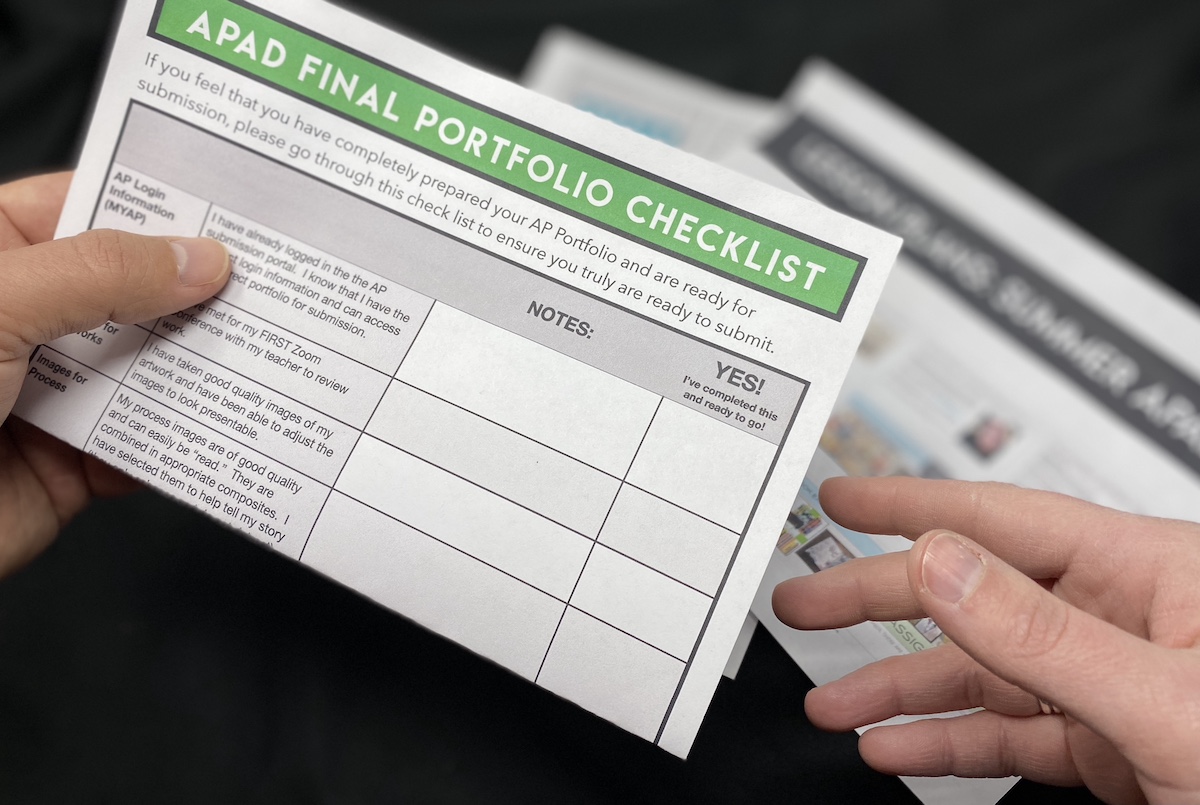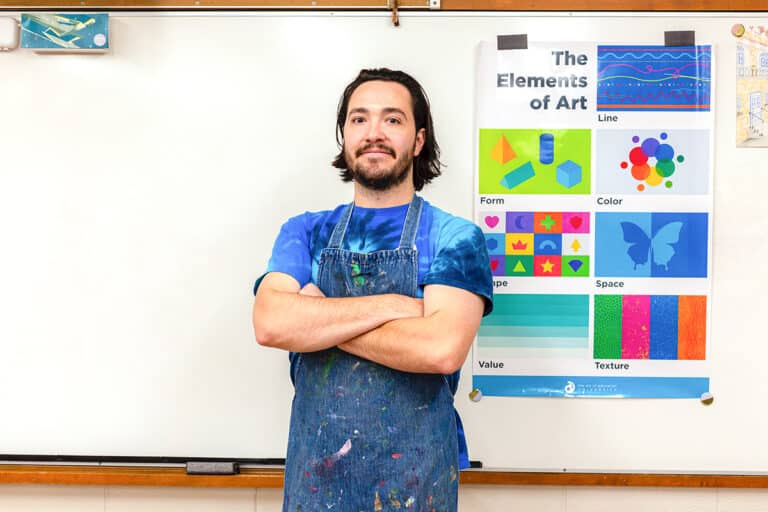Art teachers make up an amazing and unique community. Because we build almost everything from scratch, sharing content is one way we support each other and celebrate our students’ incredible achievements. With so much involvement in social media and recent changes in learning environments, there have been plenty of ideas to go around. But what happens when you see something shared by a teacher that looks a little too close to what you’ve created and already shared?

Why is sharing content so important?
Sharing lessons, worksheets, or even general ideas benefits everyone. When we share an idea on a social media thread, we engage in creative thinking and discourse. We connect with our global community through meaningful conversations in art and art education. We are reminded we are not alone, and the world is so much larger than our own bubble.
Many teachers share lessons on a blog, website, or another online forum. When we finish a lesson we are proud of, writing it up and sharing it with our community is a great way to reflect and create closure to that process. We have the unique opportunity to share what went well, what didn’t, impart tips for success, and celebrate our students’ work.
Many teachers have conflicting opinions about selling and sharing their lessons. As teachers, we are selfless beings by nature. It feels strange to receive payment (even if nominal) for our hard work, especially when profiting from teachers in our same situation. But let’s be honest, no one is becoming a millionaire from this passive income. When selling lessons, however, be mindful of your school’s policies. They may have strict guidelines regarding profiting from materials created during paid teacher time, using resources created with colleagues, and using the school-owned tools and computers to create and sell content.

What really becomes an issue is when lessons shared either don’t credit the original creator or cross the line into flat out plagiarism. Let’s take a look at some do’s and don’t’s for both the teachers borrowing and those who share.
If you are the teacher SHARING your content…
DO: Consider how your work will be used.
- Teachers are inspired by your work. These teachers use your ideas as a jumping-off point to spark their own unique lessons or ideas. This is the best outcome from sharing work. It is best practice for others to make adjustments and fit the needs and interests of their students.
- Teachers modify your shared materials. In this case, you will see student examples out there that look similar to your lesson. These teachers use the basic framework but tweak parts like materials or themes to fit within their existing curriculum.
- Teachers use your work as-is with little to no modification. Sometimes teachers are in a pinch; they might go on an unexpected leave or be out sick for a few days. Sometimes teachers are exhausted and need support by reusing an existing lesson with ensured success.
DO: Assume positive intent.
Be careful calling out others for “stealing” your ideas. It’s one thing if you see your exact work without giving any credit. It’s another to see something somewhat similar, but not exact. The great thing about the internet and social media is that many people are discussing and sharing. We might come up with ideas by consciously searching for something specific. But sometimes, ideas spark subconsciously as we scroll through interesting threads. In our classes, we model and discuss the differences between inspiration, appropriation, and plagiarism. Ideas aren’t really original but borrowed and remixed. The same goes for our lessons.
Sure, sometimes ideas are unique, but our first step should be to assume positive intent. Art teachers aren’t conspiring to take credit for someone else’s lesson. But we sure are passionate about our work and that of our students. Everyone is trying to the best they can with what they have. When someone posts great outcomes, we should be celebrating.
If you are the teacher BORROWING the content…
DON’T: Resell someone’s materials as your own.
This seems pretty obvious, but unfortunately, it happens. Thankfully, this rarely happens with art teachers we know personally. More often, it’s a random person not even affiliated with art education trying to make a quick buck. However, if you snag someone’s content, it should go without saying—absolutely no reselling as your own. Period.
DON’T: Share someone else’s materials without giving them credit.
A little mention, a tag in a post, or adding original contact information to materials goes a long way—teachers who share LOVE seeing how others are using their lessons and how students are inspired. Let’s see it! Share your student work and tag your inspiration.
DON’T: Claim a borrowed lesson as your own.
Your students’ successes should be celebrated. But when art teachers say, “Wow! That’s such a great lesson! Can you share with me?” Make sure to credit the original creator before passing on the content to others.
DO: If you don’t know where your images came from, say that.
Collaborating and sharing with our colleagues is a great way to break up your workload. Before posting to social media, make sure you check with your colleagues. If you don’t know where they got their materials, say so. This helps you stay on the up-and-up. Often, someone in the thread will tag the original creator, and everyone wins.
DON’T: Expect teachers who share content to hand it all over.
If a teacher posts artwork examples and handout images, but not the real deal, don’t expect them to hand over all of their hard work. There are reasons a teacher hasn’t posted original materials. They might not feel comfortable with you reusing their work without modifying it for your classroom. They may have been burned before when others resell or share their work without credit. Or, they might not know where their original images came from and don’t want to pass along uncredited work. While you are always welcome to ask for more supports and materials, don’t expect teachers to share them fully every time.
DO: Offer to share back.
If a teacher shares with you specifically, offer something in return. Even if it’s a thank you, images of your student’s artwork using that lesson, a modification you made to the lesson, helpful tips for others, or even a different lesson or idea you have to share. Again, a little goes a long way.
What’s the best way to credit someone?
If you share work inspired by or borrowed from another art teacher, make sure you give them credit. If you know who they are, ask them first. Most art teachers are not looking for celebrity status and are happy to share. It’s only polite to credit your source, even as a gentle nod of gratitude.
What should I say when posting others’ materials, even when I’m not sure where it came from?
One of the biggest issues with not being credited comes directly in the way something is shared. Make sure to include who or what inspired you in your comment directly in the main post. It’s okay if you don’t know where something originated, but if you know you have seen it elsewhere, just say so. A great example is to say something like, “Take a look at my student’s awesome artwork!” and follow up with:
- This lesson was inspired by…
- This lesson was developed by…
- You can find the original lesson here…
- I’m not sure where this content came from originally, but check out this lesson my colleague shared with me!
- I’m not sure where the original lesson came from, but look at my students’ incredible results!
What should I do when something looks like it was borrowed from me and not credited?

- Realize that sometimes it just happens. You’re looking through a recent thread and think to yourself, “Wow, that looks really close to my lesson I just posted.” While our first instinct may be to feel offended, this is also a great time to model positive intention and politely educate.
- Educate others instead of shaming or blaming. Some new teachers aren’t really aware of the best ways to share content. Others might be posting in haste with no ill intentions. Instead of accusing someone of wrong-doing, be cautious and approach this sensitive situation with professionalism.
- Communicate in private. Reach out to the person individually first instead of finger-pointing in a public thread. Publicly shaming someone just makes you look bad. Instead, share your concerns privately to discuss further.
- Oops! I was wrong. What if you accuse someone of “stealing” your work but then you realize you were wrong? If you are coming from a place of positive intent, then you are careful of accusing others in the first place. It’s much easier to apologize for the mistake with grace than to backtrack your accusatory remarks.
The art education community is smaller than we think. As we have shifted to more online learning, sharing content is at an all-time high. Remember, give credit where credit is due, assume positive intent, and continue to share. Be polite and professional whether you are on the receiving or sharing end. Let’s do what we can to support each other and our students. No one is looking to become a celebrity; the least we can do is bolster each other in the midst of all the incredibly hard work we are doing.
What are your favorite online places to share content?
How do you handle a situation where you feel you have not been given credit?
In what ways can you remind yourself to assume positive intent?
Magazine articles and podcasts are opinions of professional education contributors and do not necessarily represent the position of the Art of Education University (AOEU) or its academic offerings. Contributors use terms in the way they are most often talked about in the scope of their educational experiences.





